Originally presented at the 2016 ASEE Annual Conference & Exposition, New Orleans, Louisiana, June 26, 2016, Conference Session “Promoting Engineering and Technological Literacy.”
©2016 American Society for Engineering Education, ASEE Annual Conference Proceedings, New Orleans, La.
Abstract
The United States Standards Strategy, the framework developed by the American National Standards Institute (ANSI) to guide the U.S. standards system, recognizes the need for standards education programs as a high priority and recommends initiatives that address the significance and value of standards.
To this intent, a novel workshop was developed in partnership with the library and the School of Engineering to raise the level of awareness of technical standards and standards usage on campus. The effort was a result of a campus-wide collaboration that provided a low-cost method of introducing technical standards and providing a foundation to develop a series of online tools accessible to the campus community. The event featured guest speakers representative of six major national and international standards bodies in addition to faculty, staff and students. The panels provided discussions on the background of the various types of standards and industries impacted, the development and implementation of these documents, the ways in which students and faculty can become more familiar with these documents and the benefit to becoming actively involved with standards organizations. The presentations and question-and-answer sessions provided a venue to learn about technical standards and to talk about ways to improve standards education within the campus community. The event was well received as shown by strong attendance and follow up to online materials continues to show activity five months following the event.
This paper summarizes the implementation of the workshop, its impact, and strategies to further improve standards education on campus.
Introduction
Technical standards are recognized as essential for economic growth and for facilitating global trade system liberalization. Recognizing the overall importance of standards, the American National Standards Institute (ANSI), in collaboration with other national organizations, has developed the United States Standards Strategy (USSS) that states that simple familiarity with standards is not enough but that there is need for firm education on the fundamentals of standards and their respective implementation.1
It is widely recognized that engineering students do not get much exposure to standards while in school.2-4 Through a study done in 2004, it was revealed that standards education was not considered a priority at the institutions surveyed.5 However, employers have expectations that new hires have knowledge of standards and their applications.3,4 Additionally, many standards developing organizations (SDO) encounter difficulties in recruiting the experts and leaders that can ensure successful continuation of their mission.6 As a result, the Unites States Standards Strategy established standards education as a high priority in the U.S.
Efforts in that direction started in 2000, when ABET, recognizing the benefits of including technical standards into engineering education, included a reference to standards and codes in General Criteria, Criterion 5, requiring that all major design experience should incorporate appropriate engineering standards. Moreover, to provide additional opportunities for education on standards, many SDOs have established education committees with the goal to assist engineering and technology programs. Standards education is accepted as highly beneficial to engineering students6-9 but there are discussions whether it should stop at introducing the theoretical rules and use7 or should it also include the development process.10
The most effective way to introduce standards to engineering students was determined to be by inclusion into engineering curricula or use of standards in the classroom.8-11 However, although recognized as efficient, standards inclusion into curriculum is still not common practice due to a variety of reasons. One of the main reasons is that engineering curriculum is highly intensive in technical subjects which, in turn, leaves little room for auxiliary courses on other topics of interest to engineers (i.e. project management, standards, ethics, etc.). Other reasons for the lack of curricula adoption is that many engineering faculty have little or no knowledge of practitioner standards6 and that training them to recognize standards value is time consuming,11 while textbooks and handbooks are quickly out of date since standards are reaffirmed or revised every five years.6 Moreover, the development of new courses or the changing of curricula is a challenging process.11 That is why the USSS recommends a concerted effort for identification of new ways to teach about standards, both from the universities and SDOs.1 Following this directive, many SDOs have developed a plethora of online training materials. However, these are difficult to discover, difficult to understand, and many times they are not available for free.6 Other initiatives include workshops organized in either collaborations by industry, government, and academia12 or as a singular effort. Initiatives from universities include use of standards in capstone projects12-13 and design classes.14-15 Academic libraries also play a role in standards education by providing campus-wide access to standards collections, teaching about standards through research guides,16 library instruction sessions,17 collaboration with faculty18 and organizing small scale local workshops, etc.
On our campus, the analysis of a library survey sent to returning co-op students by the engineering librarian revealed a strong need for standards education. There was also interest in developing a standards workshop from two graduate students who were active members of ASTM International. Through collaboration, plans had expanded from the initial idea of presentations by the two graduate students, to a workshop that would include two sessions – one session for the faculty and students representing the campus community and one session for representatives from national standards organizations.
Workshop Development
Due to the scope of the workshop, the key to its success was to gauge faculty interest early and ensure their cooperation for such an event. Throughout many meetings representing all School of Engineering departments, the faculty expressed enthusiasm for the workshop concept, contributed ideas on planning the event and had recommended organizations of interest to them. With the faculty help, it was decided that the best time for the workshop would be at the beginning of the fall semester. Some faculty deemed the workshop so relevant to their classes that they decided to include it in their syllabus for the fall and make it mandatory for their students to participate. One other very important idea suggested by faculty was that the workshop be recorded and made available online so that it could be available to those not participating in the workshop and enabling its content be reused in future courses. This initial planning step also helped secure the faculty speakers for the campus session.
The faculty enthusiasm was so great that the news about the workshop reached multiple offices on campus that were interested in offering event support. The Division of Engineering Leadership and Professional Practice (DELPP) office offered to sponsor the recording of the workshop and help with advertising to the engineering students. The office for Corporate Relationships provided a connection to and assistance in securing a speaker from a standards organization of great interest on campus. The Case Alumni Society, the Graduate Student Council, the Materials Graduate Society and the Materials Science and Engineering Department offered financial support to ensure a successful event. Finally, the library coordinated the video recording and means to have the videos available on campus and linked through the library website.
The main goals for the workshop were to increase standards awareness on campus – what are technical standards, the important role they have for the global economy and what benefits students could have by using standards. To reach these goals, it was necessary that the workshop provide a general introduction to standards and provide a forum to allow interaction between faculty, students, staff and standards personnel. In order to represent the extensive impact that technical standards have on a wide range of industries, it was necessary that a variety of different standards bodies and faculty from various disciplines be represented. This wide representation was necessary to maximize the reach to students of different engineering disciplines.
Consequently, the workshop was organized as two panels sessions, each including time for questions and answers. The first panel featured guest speaker representatives from six major national and international standards bodies identified as being of major interest on campus. The organizations included ASTM International, American National Standards Institute (ANSI), Institute of Electrical and Electronics Engineers (IEEE), Association for the Advancement of Medical Instrumentation (AAMI), CSA Group, and Underwriters Laboratories (UL). Their role was to discuss the background of the various types of standards and industries impacted, the development and implementation of these documents, the ways in which students and faculty can become more familiar with these documents and the benefit to becoming actively involved with standards organizations. The second panel featured four faculty representing Biomedical, Electrical, Mechanical and Aerospace, and Materials Science and Engineering, one graduate student, and the engineering librarian. Second panel speakers showcased standards work occurring on campus by sharing their experience in using standards in research, curricula or industry, involvement with standards development as well as standards availability through the library. Each presentation was scheduled to last five minutes to allow for fifteen minutes of questions and answers during each session. The two panel sessions were separated by a fifteen minute break that allowed for networking and discussions between the participants. Due to the rapid succession of presentations, a moderator for the workshop was also invited. The moderator, a NASA scientist, could also speak from his own experience working with standards.
The workshop was heavily advertised on campus using multiple venues. As the workshop was scheduled within one week from the beginning of fall semester, one email containing a short announcement was sent early in August to all engineering faculty. Multiple flyers and posters were posted around the campus and within the library before school started. During the first week of school, a second email was sent to faculty including all the details of the workshop, asking them to attend and recommend the event to students. Another email was sent to all engineering students using the internal listservers. DELPP office sent another email to all engineering students. Information about the workshop was published by the campus newsletter, library blog, Graduate Student Council website and all the electronic displays on campus. The library guide for standards was updated to include information on the workshop, PowerPoint presentations from all speakers, Technical Standards infographic19 with a very succinct introduction to standards (Appendix A) and to manage the registrations. The infographic was handed to all workshop participants. At the time of registration, participants’ status and department were collected for assessment.
After the workshop, video recordings of all the presentations were posted on the university YouTube channel and linked to the library guide. In order to get feedback on the workshop, two different surveys were sent, one to all speakers and one to all participants. Questions on the survey sent to speakers dealt with their opinion on the workshop organization and whether they would consider participating again in the future. Questions on the survey sent to participants dealt with perceived benefits and learning experience offered by the workshop and whether they considered it a worthy event to participate in the future. A post event press release was published for the campus community and for the guest organizations.
Assessment
The event was evaluated in terms of campus participation, survey results from the panelists and attendees, event reach and event impact. Online registration was reported as 209 registrants. The breakdown of registrants is provided in Figs. 1a-c. Schools represented by the registrants included the School of Engineering, School of Arts and Sciences, School of Business and the library (Fig. 1a). As expected, the majority of the interest in the workshop came from the School of Engineering. Figure 1b breaks down the number of registrants by role within the university, separating by students, staff and faculty. Interest by the undergraduate population was particularly strong as 70% of the registrants represented undergraduate programs. Figure 1c shows a breakdown of the registrants by department. This provides insight into which departments overall expressed interest in the workshop. The Department of Mechanical and Aerospace Engineering and the Department of Materials Science and Engineering collectively represented 64% of the registrations.
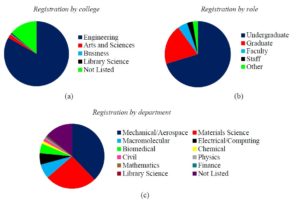
Figure 1. Breakdown of the workshop registrants by (a) college, (b) role within the university and (c) department
Feedback from the panelists was collected to help plan similar-type events through a post-event survey. Overall, the responses from the panelists were extremely positive concluding that the workshop was both well organized and of appropriate length. Specific suggestions to improve future workshops were made by panel members (denoted as “Other” in the Fig. 2). Many noted that the addition of an overview of standards presentation preceding the individual organization talks to provide an overview of the U.S. National Standards system would be beneficial. This would lay the groundwork for how each of the participating societies fit into the overall standards system. While an infographic on standards was distributed with electronic registration and as a handout at the event, the authors agree that a brief overview may have been beneficial at the onset of the workshop. The remainder of the respondents for that questions recommended focusing the workshop to a specific audience. Once the introductory material was presented, follow up sessions could concentrate on a specific discipline’s needs, or look more in depth into a particular SDO.
At the conclusion of the survey, panelists had the opportunity to provide additional feedback. The primary concern was the time allotted for the individual talks as many felt it was too short to allow for an appropriate coverage of their organization’s information. Many of the speakers found the five minute presentation difficult to adhere to and most talks ranged from slightly over five minutes to eleven minutes in length. The intent of the short presentation time was to allow for more time in the question and answer session. The author’s believe that limiting the talks to ten minutes would allow for ample information coverage, but that it would be important to monitor the question and answer sessions and breaks more carefully to ensure the event did not go over time.
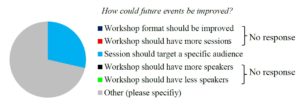
Figure 2. Results from the panelist survey based on how the event could be improved
The results of the attendee survey mirrored the panelists’ responses on the organization and length of the workshop again noting that it was a well-organized event and the length was appropriate, though a small percentage felt the event was somewhat long. In addition to these questions, the attendees were also asked to reflect on their thoughts regarding workshop content, suggestions for future events, if they would consider attending again and most importantly the benefit(s) from attendance. The attendees overwhelmingly replied that the topic was of interest to them and that some to most of the information was new. Considering the majority of the audience was composed of undergraduates, the workshop proved to be a great venue to introduce students to essentially new material. Interaction between the students and panelists was engaging and many lively discussions occurred during the question and answer period that addressed fundamental applications of standards. Attendees had the opportunity to provide suggestions to aid in planning future events as well as addressing the question directly by choosing from the responses as shown in Fig. 3. Similar to the panelists’ responses, the attendees chose to provide their own suggestions which included a desire to hear more about the student advantages to becoming involved with standards and standards organizations, how could standards get integrated into the classroom if not currently done and to consider adding other SDOs to the panel. In addition, many respondents commented on the enthusiastic presentations and interactions between panel members and between the panel and audience during the first half of the workshop. Based on the survey questions and additional comments, the majority of the attendees would prefer an interactive workshop format that would be smaller in size. This would also allow the ability to target more specific topics in standards education and implementation.
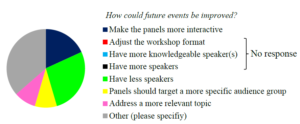
Figure 3. Results from the attendee survey on how the workshop could be improved
When asked about attending a future event on standards education, the attendees overwhelmingly agreed it would be of interest to them. Of the 75% that expressed an interest in attending again, half noted that a year in between workshops was an appropriate amount of time. Figure 4 shows the breakdown of responses.
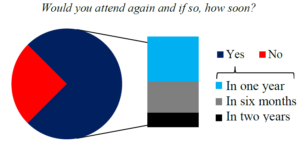
Figure 4. Results from the attendee survey on whether there was interest to attend a future workshop and if so, how soon
Finally, and perhaps most importantly, the attendees were asked about the benefit they received from attending the workshop. The questions were asked to generate a sense of how much the attendees were aware of the use of technical standards at the university and if upon completion of the workshop there was an improved understanding of what standards are and their usage. The majority of the attendees noted at least some awareness of technical standards used at the university. It would have been interesting to have asked more questions about their awareness, to perhaps better target information/awareness gaps for future sessions. Following the workshop, the attendees reported an increase (Fig. 5) in understanding of the material which met the authors’ goal of improving standards awareness.
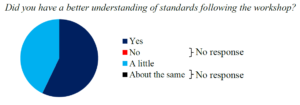
Figure 5. Results from the attendee survey on improved understanding of standards following the workshop
The reach of the event was measured by the number of times the online videos of the presentations were accessed through the university YouTube channel. These values provide an indication of interest in the presented material outside of the workshop attendance. Event videos and corresponding presentations were uploaded following the event. The number of viewings was measured at the beginning of January and resulted in a total of 584 views. A second measurement was made at the end of January which showed a 22% increase in views for a total of 714. This demonstrates a continued interest in the online materials and particularly the presentations related to the various standards bodies that participated in the event. Figures 6a-b depict the number of times presentations were accessed online with Fig. 6a providing the breakdown of views by panel type and Fig. 6b and by individual presentation.
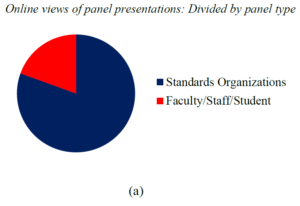
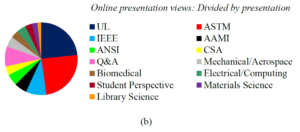 Figure 6. Views of online presentation videos broken down by (a) panel type and (b) individual presentation
Figure 6. Views of online presentation videos broken down by (a) panel type and (b) individual presentation
In addition to videos of the workshop presentations which are hosted on the university YouTube channel, supplementary material on standards was also provided on the library website. This research guide provides resource material for faculty to use in the classroom, methods to find standards through the library, an overview of standards and all of the standards workshop information. In December, a new category was added to the online guide to address the use of standards in education. Examples of how faculty can implement standards education in the classroom are provided. Metrics from the site are noted in Fig. 7 beginning from September 3 (the day after the workshop) to January 31.
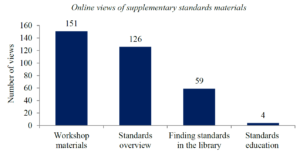
Figure 7. Views of supplementary materials on standards provided through the library research guides
Post-event impact was evaluated through the review of the participant surveys as noted previously, reach of message (news items linking back to the event), and classroom impact.
Surveys from the audience members demonstrated an increase in knowledge and exposure to standardization. Reach of the event and the ability for more individuals to have access to the workshop materials (i.e. handouts, videos) beyond the campus community was demonstrated by the coverage of participating organizations. An article (ASTM International) and news blogs (ANSI, AAMI) were uploaded to organization web sites noting the event and benefits of participation while another provided information on how to link back to the workshop materials (IEEE). News of the success of the event led to contacts from NIST for the faculty to become aware of grants to develop programming for the classroom which two faculty are in the process of pursuing. Some attending faculty used the event as a class activity. Design for Manufacturing I, Design for Manufacturing II, and Structural Materials by Design courses each used the event as an opportunity to introduce the concept of standards. The design courses used the workshop as in introduction to standards then following the event discussed how the standards would be applied to their design projects; both classes were expected to reference the applicable standards for their designs. The Structural Materials by Design course used the online videos as part of a homework assignment wherein students were asked to review and summarize a presentation.
Conclusions
This paper presented a novel way to implement an introduction to standards to the campus community. The workshop was successful based on the good participation and feedback from the panelists and attendees. The key to event success was engaging the faculty. Coordinating with faculty to find ways to include the workshop material as part of a class discussion, homework assignment or other activity further exposed students to standards and reiterated their importance and impact. Furthermore, the online availability of workshop presentations and the low cost of implementation allow for the development a flipped classroom model.
Another key element was identification of SDOs based on the needs of the campus community. This ensured a strong interest from faculty and students alike and provided reasons for good participation. The SDOs welcomed the opportunity to participate in the event and were very supportive of the initiative. Their actions following the workshop proved they found the event beneficial and would like to expand it to other institutions. Continued investigation and collaboration with educational outreach committees will enhance such future events.
While the overall event was extremely successful, there are several ways that the workshop could be improved. As noted by the panelists, an introductory presentation should be included and could easily be delivered by the event moderator. The presentation should be a brief introduction to the U.S. Standards System and how each of the presenting organizations factor into the overall program. The panelists also suggested that providing topics to cover in advance of the event would help keep the presentation length manageable and on target.
To help with targeting future events, particularly those that may focus on specific applications of standards, the request of additional information in the online registration could be beneficial. Collecting information prior to the event on basic knowledge, exposure or usage of standards would aid in determining the value of the workshop for the attendees. Based on the interest in the online presentations and supplementary materials provided through the library website, the authors consider that the development of an online presentation database to encompass a variety of SDOs would benefit a larger set of disciplines on campus. In turn, more faculty could utilize the materials in more classrooms.
The combination of workshops and an online presentation database could become an inexpensive and effective solution to expand standards education on campus without having to develop standalone courses or substantially changing existing curricula. In our experience, the School of Engineering, various campus offices and the library created the best partnership in making this event successful.
Acknowledgements
This project was supported by the Kelvin Smith Library, Case School of Engineering Division of Engineering Leadership and Professional Practice, Department of Materials Science and Engineering, Case Alumni Association, Graduate Student Council and Graduate Materials Society. The authors appreciate the participation of AAMI, ANSI, ASTM International, CSA Group, IEEE and UL and the active role of numerous Case Engineering faculty and students, and in particular, Professors James Anderson, Sunniva Collins, John Lewandowski, Francis Merat and graduate student, Mohsen Seifi.
References
1. American National Standards Institute. 2010. United States Standards Strategy. Available from https://www.ansi.org/standards_activities/nss/usss.aspx?menuid=3
2. Forbes R, Emplaincourt M. A . 2003. Case Study in Product Liability and Standards. In: Proceedings of the 110th ASEE Annual Conference, June 22-25, 2003, Nashville, TN. Available from: https://peer.asee.org/11977
3. Harding B, McPherson P. 2010. What Do Employers Want in Terms of Employee Knowledge of Technical Standards and the Process of Standardization? In: Proceedings of the 117th ASEE Annual Conference, June 20-23, 2010, Louisville, KY. Available from: https://peer.asee.org/16474
4. Schultz D. 2005. Standards in the Classroom. ASTM Standardization News. July. Available from: http://www.astm.org/SNEWS/JULY_2005/schultz_jul05.html
5. Center for Global Standards Analysis. 2004. Report on a Survey of Schools of Engineering in the United States Concerning Standards Education. Washington, DC: The Catholic University of America.
6. Harding B, McPherson P. 2009. Incorporating Standards into Engineering and Engineering Technology Curricula: It’s a Matter of Public Policy. In: Proceedings of the 116th ASEE Annual Conference, June 14-17, 2009, Austin, TX 2009. Available from: https://peer.asee.org/5204
7. Cooklev T. 2010. The Role of Standards in Engineering Education. International Journal of IT Standards and Standardization Research. 8(1):1-10. Available from: http://dx.doi.org/10.4018/jitsr.2010120701
8. Jenkins MG, Nguyen TM. 2012. Standards in the Classroom: Guidance and Opportunity. ASTM Standardization News. November/December: 16-17. Available from: http://www.nxtbook.com/nxtbooks/astm/sn_20121112/index.php?startid=16
9. Institute of Electrical and Electronics Engineers. 2009. IEEE Position Paper on the Role of Technical Standards in the Curriculum of Academic Programs in Engineering, Technology and Computing. Available from: https://www.ieee.org/education_careers/education/standards/standards_position_paper.html
10. Olshefsky JP. 2008. The Role of Standards Education in Engineering Curricula. In: Proceedings of the ASEE Conference, Mid-Atlantic Section. Available from: http://www.astm.org/studentmember/PDFS/Role_of_Standards.pdf
11. Krechmer K. 2007. Teaching Standards to Engineers. International Journal of IT Standards and Standardization Research. 5(2):17-26. Available from: http://www.irma-international.org/viewtitle/2586/
12. Kelly W, Suett P, Bickart TA. 2005. Incorporating Standards into Capstone Design Courses. In: Proceedings of the 112th ASEE Annual Conference, June 12-15, 2005, Portland, OR. Available from: https://peer.asee.org/14650
13. Dutson AJ, Todd RH, Magleby SP, Sorensen CD. 1997. A Review of Literature on Teaching Engineering Design through Project‐Oriented Capstone Courses. Journal of Engineering Education. 86(1):17-28. Available from: http://citeseerx.ist.psu.edu/viewdoc/download?doi=10.1.1.33.3949&rep=rep1&type=pdf
14. Kunst BS, Goldberg JR. 2003. Standards Education in Senior Design Courses. IEEE Engineering in Medicine and Biology Magazine. 22(4):114-117.
15. Kelly W. 2003. Incorporating Engineering Standards in the Major Design Experience. In: Proceedings of the 110th ASEE Annual Conference, June 22-25, 2003, Nashville, TN. Available from: https://peer.asee.org/12427
16. Erdmann C. 2010. Standards for New Educators: Guide To ABET Outcomes And Standards Availability In Libraries. In: Proceedings of the 117th ASEE Annual Conference, June 20-23, 2010, Louisville, KY. Available from: https://peer.asee.org/16224
17. Waters N, Kasutoa E, McNaughton F. 2012. Partnership between Engineering Libraries: Identifying Information Literacy Skills for a Successful Transition from Student to Professional. Science & Technology Libraries. 31(1):124-132.
18. Leachman C, Pezeshki C. What’s Standard? Industry Application versus University Education of Engineering Standards. In: Proceedings of the 122th ASEE Annual Conference, June 14-17, 2015, Seattle, WA. Available from: https://peer.asee.org/25068
19. Maan HJ, Greulich OR. 2014. Primer on Engineering Standards. New York, NY: ASME Press.
Appendix A
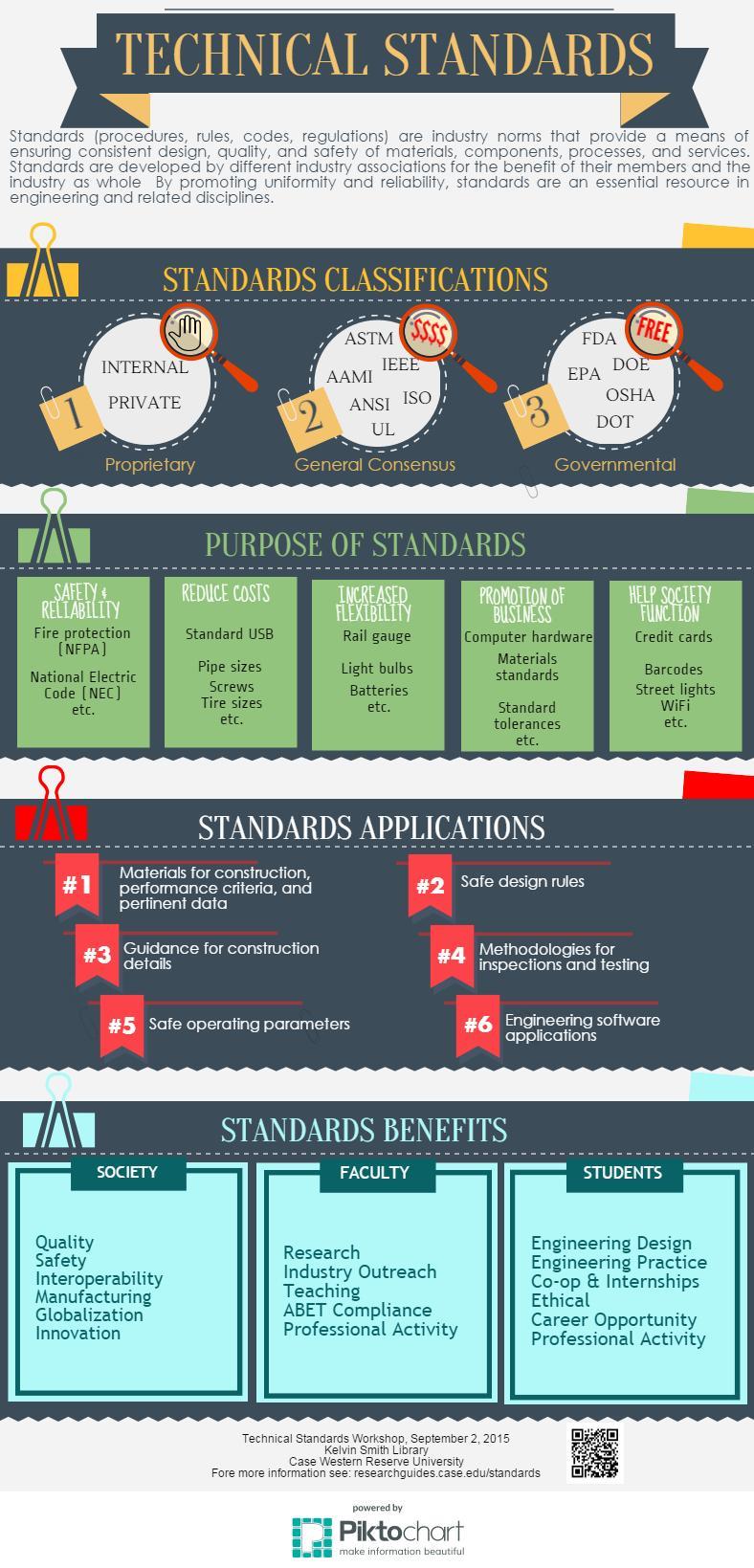
Miss Janet L. Gbur
Case Western Reserve University
Janet L. Gbur is a Doctoral Candidate at Case Western Reserve University in the Department of Materials Science and Engineering. She obtained a B.S. in Biology/Pre-Medicine at Kent State University and a B.E. in Materials Engineering and M.S.E. in Mechanical Engineering both from Youngstown State University. During her time at CWRU, she has mentored numerous high school and undergraduate student research projects that have focused on the mechanical characterization of wires used in biomedical applications. Her dissertation research investigates the effects of inclusions on the fatigue life of superelastic Nitinol fine wire and she is also involved in projects evaluating the reliability of implantable electrodes and characterizing the fatigue behavior of dental archwires. Janet is an active member of ASTM International, serving on E04 Metallurgy, E08 Fatigue and Fracture, and E28 Mechanical Testing Committees and also holds memberships in ACerS, AIST, ASM International, MSA, MRS, Microscopy Society of Northeastern Ohio, SAMPE, SWE, and TMS.
Mrs. Daniela Solomon
Case Western Reserve University
Daniela Solomon is Research Services Librarian for Biomedical Engineering, Civil Engineering, Electrical Engineering and Computer Science, Materials Science and Engineering, Mechanical and Aerospace Engineering at Kelvin Smith Library, Case Western Reserve University. She is interested in bibliometrics, altmetrics, data management, and library instruction.
